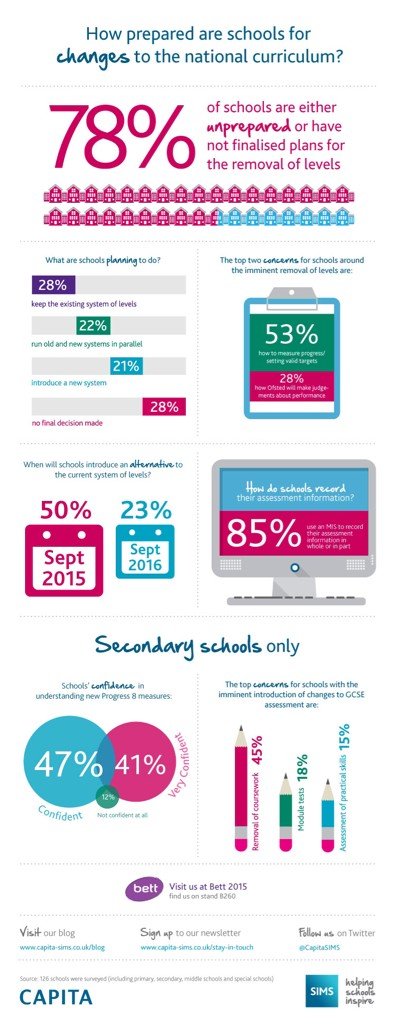Schools’ approach to assessment without Levels
When Michael Gove told everyone that Levels were not fit for purpose, so we don’t have to use them, we were given a great opportunity to rethink how we assess students and how to report our judgements. Unfortunately, I have had the distinct impression that many of us were finding it hard to do so. It seems that I was not imagining it.
I gained that impression from two main sources. First, by looking through the various assessment models uploaded to the Computing At Schools resources section. Don’t get me wrong: I’m not knocking them at all. I have found all of them to be useful, and I have shared some of them (with permission) with students on a PGCE (teacher training) course I’ve been teaching on, and with colleagues on the courses I’ve run on assessing computing and ICT. As you might expect, some people liked a particular approach, and some people disliked that approach and some people, like myself, felt that sometimes a hybrid approach between two or more of the schemes would be best of all.
However, apart from a few examples, most of them use Levels, even if they don’t actually call them Levels. What are different coloured badges, for example, or text, if not Levels by another name?
Well, it seems that my impressions have some merit. I’ve heard David Brown, the HMI responsible for ICT at Ofsted, say a couple of times that inspectors are finding that many schools are still using Levels. Now, some research from Capita-SIMS seems to bear this out, as you can see from the infographic below. The headline figure is that 78% of schools are unprepared for, or have not yet finalised plans for, the removal of Levels.
I say “seems” because there are a few caveats.
First, only 126 schools were surveyed, so I am not sure how representative they are.
Second, in the absence of information about how the schools were selected in the first place and then how the data was processed to take account of the small sample size, I think it safer to regard the statistics as indicative rather than definitive. Mind you, I think that about most statistics!
Third, even accepting the data on its own terms, once you look a bit closer you can see that the situation is not quite as “bleak” as that figure of 78% would suggest. For example, only 28% are definitely going to retain the system of Levels. Incidentally, I placed the word “bleak” in quotation marks because it is, of course, a value judgement. I used it because I think we have a great opportunity to try out something different, and it seems to me that it would be a shame not to.
But the key thing is to at least take the opportunity to think about it. As I’ve argued in the article Assessing without Levels and elsewhere, the old system of Levels wasn’t that great anyway. You may well come to conclusion that Levels, like democracy, are the worst thing ever apart from the alternatives, but you will feel better for having had the discussion!
By the way, if you would like to read of some innovative approaches to assessment with Levels, and how they might be applied to the ICT/Computing curriculum, read the articles tagged DfE Assessment Innovation. If you prefer a collated version, you can obtain that by subscribing to Digital Education. If, for some bizarre reason, you don’t want to subscribe to a free, stupendous and incredibly useful newsletter, then you can obtain it from the resources section in CAS, here: DfE Assessment Innovation in CAS. But you’ll have to join CAS to access it.
Also, there are other articles about assessing Computing and ICT on the ICT in Education website: Assessment articles.
Anyway, here’s the infographic.  Thanks to the Catherine Lane Agency for permission to use this infograph http://www.catherinelane.com/
Thanks to the Catherine Lane Agency for permission to use this infograph http://www.catherinelane.com/
What do you think?
 Your newsletter editor is hard at work doing research for Digital Education, the free newsletter for education professionals. Have you subscribed yet?
Your newsletter editor is hard at work doing research for Digital Education, the free newsletter for education professionals. Have you subscribed yet?
Read more about it, and subscribe, on the Newsletter page of the ICT in Education website.
We use a double opt-in system, and you won’t get spammed.